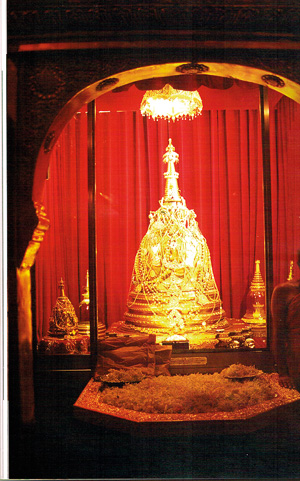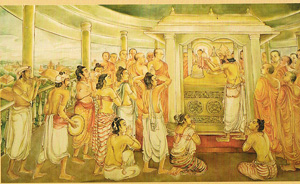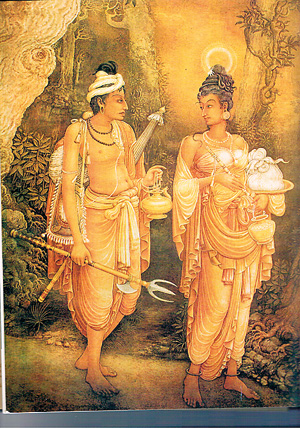The Sacred Relic that became a symbol of royalty

Relic casket in the inner chamber of the Dalada Maligawa
She is a princess. But she disguises herself as a Brahmin. Her father, the king – gives her a precious item to be delivered to a friendly monarch overseas. The king is aware of the possibility of his daughter and son-in-law being waylaid and the valuable item taken away. The pair set off with the object hidden in her hair.
The incident occurred in the 4th century CE . The king was Guhaseeva whose kingdom was Kalinga (present Orissa). The precious item was the Sri Dalada – the Sacred Tooth Relic, the left canine tooth of the Buddha. The pair was bound for Sri Lanka where the king was ruling from Anuradhapura, the nation’s first capital. It was the ninth year of reign of the king, Kithsiri Mevan who had ascended the throne in 303 CE.
Why King Guhaseeva decided to send the Relic to the Sinhalese monarch was because a king in a neighbouring kingdom was declaring war in a bid to obtain the Relic. He had advised his daughter that in case he lost the war she should immediately leave with her husband taking the Relic with them. He lost the war.
Princess Hemamala and Prince Danta found their way to Anuradhapura and were warmly welcomed by the king. He received the Tooth Relic with honour and kept it in a shrine within the royal palace, paying respects in a fitting manner.
Along with the honour accorded to the Relic and the protection offered, the Sri Dalada soon became a symbol of royalty and it came to be accepted that whoever possessed the Relic would have the legitimate right to sovereignty. Professor Senerat Paranavitana thought that it was during the Polonnaruwa period that this belief was established.The people believed that during a drought, there would be rain when the Tooth Relic was taken out in procession.

King makes offerings to the Sri Dalada - Upasena Gunawardena mural
This belief was a powerful tool for the monarch since the people in the olden days thought that one of the king’s functions was to ensure rain in time for them to start their cultivation of crops. The Tooth Relic festival was said to be one of the 64 festivals that the famous Polonnaruwa ruler, King Parakramabahu I (1153-86) organised. He sought the cooperation of the Maha Sangha to convince the people and the chiefs in his kingdom that he was their legitimate sovereign by virtue of the possession of the Tooth Relic.
The practice of keeping the Tooth Relic within the royal palace and conducting religious observances later changed when the kings started building separate temples to house the Relic. Yet he closely guarded its possession and the public could not freely worship the Relic except on special occasions when the Relic was exhibited.

Princess Hemamali bringing the Sri Dalada - Soliyas Mendis mural at Kelaniya Raja Maha Viharaya
When Magha of Kalinga started ruling from Polonnaruwa around 1215 CE, he destroyed the places of religious worship forcing the Sinhalese rulers to flee. There was a constant change of capitals but the kings saw to it that wherever they went, they protected the Tooth Relic. Historical records state that the 14th century ruler, Parakramabahu IV having established Kurunegala as the capital city, had laid down how the daily worship and rituals at the Temple of the Tooth had to be observed. Similar rules had been made for the annual procession round the city when the Relic was on public display. Special expositions were held when rains failed.
When the kingdom was shifted to Kotte the Relic was housed in a magnificent shrine near the palace and festivals were held in grand style. When the Portuguese started destroying places of Buddhist worship and massacring Buddhists, the Tooth Relic was secretly taken away to Sitavaka which was a sub-kingdom, and hidden in DelgamuvaVihara.
King Vimala Dharmasuriya who ascended the throne as ruler of Kandy in 1592, shifted the Tooth Relic from DelgamuvaVihara and deposited it in a newly built temple. The present shrine where the Relic is kept was built as a two-storeyed shrine by King Narendra Sinha (1707-39). The last king of Kandy Sri Vickrema Rajasinghe (1798-1915) added the Octagon (Pattirippuva).
A series of murals done by renowned artist Upasena Gunawarena adorn the walls of the museum at the Sri Dalada Maligawa.
Finally, the Tooth Relic found a safe abode in the Sri Dalada Maligawa. After the British captured the Kandyan kingdom and became administrators of the whole island in 1815, the custody of the Relic was handed over to the Maha Nayaka Theras of the Malwatta and Asgiriya Chapters in 1853.Today in addition to the two chief prelates, the Diyawadana Nilame functions as the lay custodian of the Sri Dalada.
| In Tenant’s words The most remarkable object in Kandy is unquestionably the Dalada, asserted to be the ‘Sacred Tooth of the Buddha’, which for so many centuries has commanded the increasing homage of millions of devotees. It is traditionally believed to have been rescued from the flames after the cremation of the mortal remains of Gautama Buddha at Kusinara, B.C.543, and preserved for eight hundred years at Dantapura, Kalinga, whence it was brought to Ceylon in the fourth century after Christ. | |


